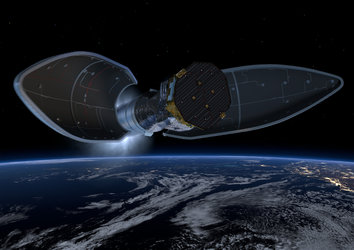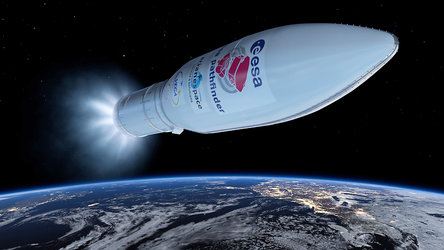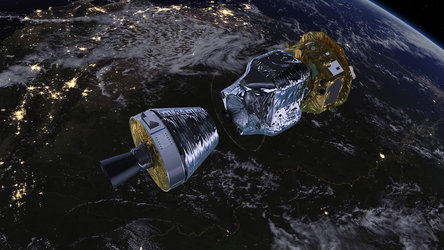Accept all cookies Accept only essential cookies See our Cookie Notice

About ESA
The European Space Agency (ESA) is Europe’s gateway to space. Its mission is to shape the development of Europe’s space capability and ensure that investment in space continues to deliver benefits to the citizens of Europe and the world.
Highlights
ESA - United space in Europe
This is ESA ESA facts Member States & Cooperating States Funding Director General Top management For Member State Delegations European vision European Space Policy ESA & EU Space Councils Responsibility & Sustainability Annual Report Calendar of meetings Corporate newsEstablishments & sites
ESA Headquarters ESA ESTEC ESA ESOC ESA ESRIN ESA EAC ESA ESAC Europe's Spaceport ESA ESEC ESA ECSAT Brussels Office Washington OfficeWorking with ESA
Business with ESA ESA Commercialisation Gateway Law at ESA Careers Cyber resilience at ESA IT at ESA Newsroom Partnerships Merchandising Licence Education Open Space Innovation Platform Integrity and Reporting Administrative Tribunal Health and SafetyMore about ESA
History ESA Historical Archives Exhibitions Publications Art & Culture ESA Merchandise Kids Diversity ESA Brand Centre ESA ChampionsLatest
Space in Member States
Find out more about space activities in our 23 Member States, and understand how ESA works together with their national agencies, institutions and organisations.
Science & Exploration
Exploring our Solar System and unlocking the secrets of the Universe
Go to topicAstronauts
Missions
Juice Euclid Webb Solar Orbiter BepiColombo Gaia ExoMars Cheops Exoplanet missions More missionsActivities
International Space Station Orion service module Gateway Concordia Caves & Pangaea BenefitsLatest
Space Safety
Protecting life and infrastructure on Earth and in orbit
Go to topicAsteroids
Asteroids and Planetary Defence Asteroid danger explained Flyeye telescope: asteroid detection Hera mission: asteroid deflection Near-Earth Object Coordination CentreSpace junk
About space debris Space debris by the numbers Space Environment Report In space refuelling, refurbishing and removingSafety from space
Clean Space ecodesign Zero Debris Technologies Space for Earth Supporting Sustainable DevelopmentLatest
Applications
Using space to benefit citizens and meet future challenges on Earth
Go to topicObserving the Earth
Observing the Earth Future EO Copernicus Meteorology Space for our climate Satellite missionsCommercialisation
ESA Commercialisation Gateway Open Space Innovation Platform Business Incubation ESA Space SolutionsLatest
Enabling & Support
Making space accessible and developing the technologies for the future
Go to topicBuilding missions
Space Engineering and Technology Test centre Laboratories Concurrent Design Facility Preparing for the future Shaping the Future Discovery and Preparation Advanced Concepts TeamSpace transportation
Space Transportation Ariane Vega Space Rider Future space transportation Boost! Europe's Spaceport Launches from Europe's Spaceport from 2012Latest

LISA Pathfinder launch sequence
Thank you for liking
You have already liked this page, you can only like it once!
Scheduled for launch in late 2015, ESA’s LISA Pathfinder will test key technologies for space-based observation of gravitational waves – ripples in the fabric of spacetime that are predicted by Albert Einstein’s general theory of relativity. Produced by massive accelerating bodies, these perturbations are expected to be abundant across the Universe, but they are yet to be detected directly.
Although not aiming at detecting gravitational waves, LISA Pathfinder will test the approach that could be used for this daunting endeavour. In particular, the goal is to achieve the best free-fall ever, reducing all the non-gravitational forces acting on two test masses and controlling any residual effect with unprecedented accuracy.
LISA Pathfinder will operate from a special location in the Sun–Earth system: the Lagrange point L1, 1.5 million km from Earth towards the Sun. After launch, it will take the spacecraft about eight weeks to cruise towards its operational orbit around L1.
First, it will lift off on a Vega rocket from Europe’s Spaceport in French Guiana, as shown in the left frame of this illustrated sequence. The Vega rocket, which is specially designed to take small payloads into low Earth orbit, will place LISA Pathfinder into an elliptical orbit.
The upper right frame shows the spacecraft riding the final stage of the Vega rocket, while the fairing is being released.
After the final stage of the Vega rocket is jettisoned, LISA Pathfinder will continue on its own, as shown in the lower right frame of the sequence. During this phase, the spacecraft will use its separable propulsion module to perform six manoeuvres, gradually raising the apogee of the initial orbit.
Eventually, LISA Pathfinder will cruise towards its final orbiting location, discarding the propulsion system along the way, one month after the last burn. Once orbiting L1, LISA Pathfinder will begin six months of demonstrating the technology for future gravitational-wave observatories in space.
Full animated sequence: LISA Pathfinder launch animation
-
CREDIT
ESA/ATG medialab -
LICENCE
ESA Standard Licence

LISA Pathfinder launch (C)

LISA Pathfinder launch (B)

LISA Pathfinder launch (A)

LISA Pathfinder in low-Earth orbit (A)















 Germany
Germany
 Austria
Austria
 Belgium
Belgium
 Denmark
Denmark
 Spain
Spain
 Estonia
Estonia
 Finland
Finland
 France
France
 Greece
Greece
 Hungary
Hungary
 Ireland
Ireland
 Italy
Italy
 Luxembourg
Luxembourg
 Norway
Norway
 The Netherlands
The Netherlands
 Poland
Poland
 Portugal
Portugal
 Czechia
Czechia
 Romania
Romania
 United Kingdom
United Kingdom
 Slovenia
Slovenia
 Sweden
Sweden
 Switzerland
Switzerland
























